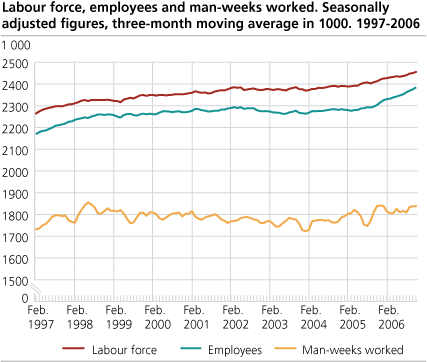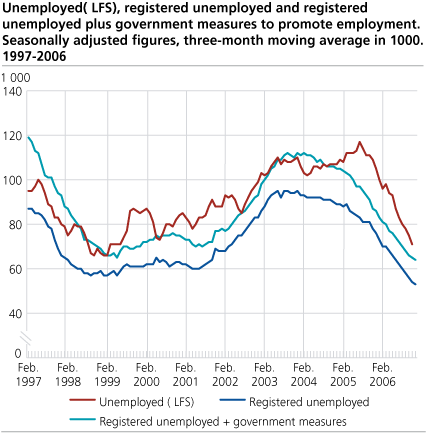Content
Published:
This is an archived release.
Number of employed people up by 81 000
The number of employed people increased by 81 000 from the fourth quarter of 2005 to the fourth quarter of 2006, according to new data from Statistics Norway's Labour Force Survey (LFS). The number of unemployed people fell by 37 000 during the same period.
|
Seasonally adjusted figures: The growth in employment continues
Adjusted for seasonal variations, unemployment decreased and the number of employed people increased from the third to the fourth quarter of 2006. Adjustments for seasonal variations allow for the analysis of current developments in the labour market, and serve as an alternative to comparisons with the corresponding quarter in the previous year. Seasonally adjusted figures are presented in a separate article . |
From the fourth quarter of 2005 to the fourth quarter of 2006, the number of employed people increased by 81 000, while the number of unemployed fell by 37 000. Thus the labour force (the employed plus the unemployed) increased by 44 000 people. This is slightly higher than the population growth: The working-age population (aged 16-74) increased by 39 000 over the same period.
The labour force participation rate is calculated by expressing the number of persons in the labour force as a percentage of the working-age population.
The labour force participation rate rose by 0.4 percentage points from the fourth quarter of 2005 to the fourth quarter of 2006. Both the female and the male participation rate increased. The labour force participation rate fell by 0.9 percentage points for younger people (aged 16-24) over the same period. This is partly due to a change in the age structure of this group: The share of the "youngest among the young" (aged 16-19) is on the increase, and this group normally has a lower participation rate. Among older people (aged 55-74), the participation rate increased by 2.6 percentage points and stood at 49.4 per cent - the highest level since the 1970s. Also for this group, a changing age structure made an impact: The share of the "youngest among the old" (aged 55-64) is increasing, and this group normally has a higher participation rate. However, it also appears that the participation rate is increasing when looking at one-year age groups, and hence, that the increased labour force participation rate among older people is not only due to a changing age structure within the group.
An important share of the total increase in employment came among people working part-time or short full-time schedules. While overall employment increased by 81 000 from the fourth quarter of 2005 to the fourth quarter of 2006, employment increased by 62 000 among people with 20 to 36 settled weekly working hours. Both full-time and part-time employment increased, but the growth was strongest in part-time employment. Nevertheless, average settled weekly working hours went up from 33.9 to 34.2. The increase in working time primarily took place among men as their settled weekly working hours were 37.4 on average in the fourth quarter of 2006, compared to 30.6 hours for women.
For the sixth quarter in a row, financial intermediation and other business activities showed the strongest employment growth. Employment growth in the two industries amounted to 33 000 people from the fourth quarter of 2005 to the fourth quarter of 2006. Other business activities include legal, accounting, and auditing services, business and management consultancy, as well as temporary staffing agencies. There was also an increase within the construction industry, where employment rose by 14 000.
Of the total growth in employment, 79 per cent was in Oslo and Akershus counties (with an increase of 30 000) and in the four counties of Western Norway (with an increase of 34 000). The six counties account for half of all employment in Norway. (Oslo and Akershus account for 24 per cent of all employed, the counties of Western Norway for 26 per cent.)
Unemployment fell by 37 000
The number of unemployed fell by 37 000 from the fourth quarter of 2005 to the fourth quarter of 2006. The decline was strongest for young people (aged 16-24): In this age group unemployment fell by 14 000. The unemployment rate (unadjusted for seasonal variations) stood at 2.5 per cent; the male unemployment rate was 2.6 per cent, the female was 2.4 per cent. The number of registered unemployed with the Labour and Welfare Organisation showed a decline of 23 100 from the fourth quarter of 2005 to the fourth quarter of 2006.
The proportion of long-term unemployed - defined as persons who have been unemployed for at least six consecutive months - was 32 per cent in the fourth quarter of 2006, up 6 percentage points from the fourth quarter of 2005. The reason for the increased proportion of long-term unemployed is that the fall in unemployment mainly has taken place among people with shorter unemployment spells.
The number of employees with temporary contracts up by 13 000
203 000 were on temporary employment contracts in the fourth quarter of 2006, an increase of 13 000 from the same quarter last year. 9.3 per cent of all employees were on temporary contracts, an increase of 0.4 percentage points from the last quarter of 2006. Temporary employment was most common within education (16 per cent of all employees), health and social work (15 per cent), and hotels and restaurants (14 per cent). At the opposite end of the scale, manufacturing (6 per cent) and transport and communication (5 per cent) are characterised by a relatively low share of temporary employees.
Number of underemployed unchanged
The number of underemployed, i.e. part-time employees who want to work more hours, was 97 000 in the fourth quarter of 2006, unchanged from the fourth quarter of 2005. The underemployed represent 15.0 per cent of all part-time employees, down 0.8 percentage points from the fourth quarter of 2005.
When accounting for the fact that many unemployed and most underemployed are looking for less than full-time work, these two groups together wanted work equivalent to a total of 84 000 full-time positions in the fourth quarter of 2006 - 31 000 less than in the fourth quarter of 2005.
Changes in the LFS from 2006
With effect from January 2006, some improvements have been made in the Norwegian LFS. This makes the employment and unemployment figures more comparable with figures from the EU-countries. In addition, actual working hours will be measured more accurately. Therefore, the changes have lead to a level shift in the LFS figures. Much of the shift can be adjusted for in the figures, and therefore, we have made two sets of figures for the fourth quarter of 2006 in the various tables. In the text above, changes (from the same quarter last year) refer to the data set containing the figures according to the LFS prior to the changes. For more details on the LFS, the seasonal adjustment method and the changes in the LFS, you can click on the links at the left side of this page.
(1) The figures for underemployment in 2006 are incorrect. More information is available here .
Tables:
- Table 1. Population aged 15-74(1) in the labour force, man-weeks worked, unemployed (LFS)(6), registered unemployed persons and persons employed by government measures (Aetat). 1000 and per cent
- Table 2. Population aged 16-74(1) år in the labour force, employed persons and unemployed persons by sex (LFS)(3). 1000 and per cent
- Table 3. Persons in the labour force and employed persons aged 15-74 by age and sex (LFS). 1 000 and per cent.
- Table 4. Population aged 15-74(1), employed persons by settled/usual working hours per week(2) and unemployed persons by age and sex (LFS)(3). 1000
- Table 5. Persons in the labour force aged 15-74 by age(1,2) and sex. 1000 and as per cent of all in each group
- Table 6. Employed persons by sex and settled/usual working hours pr week (LFS).1 000
- Table 7. Population aged 15-74 by main activity, part-time employment1 and age (LFS). 1 000
- Table 8. Employed persons aged 15-74(1) by major industry division (LFS)(2). 1000
- Table 9. Number of man-hours worked per week1, by industry division (LFS). 1 000
- Table 10. Employed persons,total, and employed persons at work by status and sex. Number of man-weeks worked1 and actual working hours per week (LFS)
- Table 11. Employed persons aged 15-74(1) and absence from work(2) during the whole reference week by reason for absence and sex (LFS)(3). 1000 and per cent
- Table 12. Employees aged 15-74(1,2) with temporary jobs, by major industry division (LFS). 1000 and as per cent of all employees
- Table 13. Unemployed persons aged 15-74(1) by sex and age (LFS)(2). 1000 and per cent
- Table 14. Unemployed persons aged 15-74(1) by duration of job search (LFS)(2). 1000 and per cent
- Table 15. Unemployed persons by main activity (LFS). 1 000
- Table 16. Unemployed and underemployed persons aged 15-74(1,2), by sex and desired working hours per week. Number of man-weeks (of 37,5 hours) supplied (LFS). 1000
- Table 18. Persons in the labour force by sex and region(LFS). 1 000 and in per cent of total.
- Table 19. Employed persons aged 15-74 by sex and region (LFS).1 000
- Table 20. Employed persons by sex and regions (LFS) as per cent of all inn each group.
- Table 21 Employed persons, by some major industry divisions and region (LFS). 1997-2006. 1 000
Contact
-
Arbeidsmarked og lønn
E-mail: arbeidsmarked@ssb.no
-
Erik Herstad Horgen
E-mail: erik.horgen@ssb.no
tel.: (+47) 93 08 68 62
-
Håvard Hungnes Lien
E-mail: havard.lien@ssb.no
tel.: (+47) 40 90 26 06


